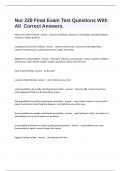Nur 229 Final Exam Test Questions With
All Correct Answers.
Aspects of Critical Thinking - Answer purpose of thinking, adequacy of knowledge, potential problems,
resources, critique decisions
Competencies of Critical Thinking - Answer patient-centered care, teamwork and collaboration,
evidence-based practice, quality improvement, safety, informatics
Attitudes for critical thinkers - Answer self-aware, effective communicator, curious, intuitive, confident,
autonomous, open and fair-minded, creative, persistent, reflect, trial and error
basic critical thinking - Answer by the book
complex critical thinking - Answer start to think on your own
content guidelines for quality reporting documentation - Answer what you DID, need to have times,
what happened AFTER you did something, factual
timing guidelines for quality reporting documentation - Answer never chart in advance, have a pad of
paper to write down each thing that happens, chart ASAP but you will be busy
format guidelines for quality reporting documentation - Answer organized (go in order), be cautious of
abbreviations you can and cannot use, proofread
accountability guidelines for quality reporting documentation - Answer responsible for your own
documentation, signed, cannot change after signed
biggest charting mistake - Answer charting ahead of time
,Narrative charting - Answer tells a story of what happened; significant findings or "exceptions" to
standard are documented in narrative form
Levels of critical thinking - Answer Basic, Complex, Commitment
Commitment level of critical thinking - Answer make choices for yourself and you are accountable for
them
subjective data - Answer things a person tells you about that you cannot observe through your senses;
symptoms
objective data - Answer information that is seen, heard, felt, or smelled by an observer; signs
SOAP/SOAPIER charting - Answer subjective data, objective data, assessment, plan, intervention,
evaluation, response
PIE charting - Answer problem (nursing diagnosis), intervention (what you decide to do), evaluation
(patient response to intervention)
Focus (DAR) Charting - Answer Data (subjective and objective), action (intervention), response
(patient's response)
verbal orders of reporting - Answer only for emergencies (when patient becomes unstable/life
threatening situations), need to document all orders, HCP signature
telephone orders of reporting - Answer read the order back to provider to double check you got it
correct
incident/variance report - Answer -when there has been anything out of the normal when it comes to
standard of care (when a patient falls, wrong medication)
-does not go on patients chart, goes to risk management ***
,Nursing Process - Answer Assessment
Diagnosis
Planning
Implementation
Evaluation
Nursing Process: Assessment - Answer Subjective and objective data, data collection methods,
validating data, identifying abnormal data and information, data clustering
Data Collection Methods - Answer client (primary and best source of information), family and
significant others, patient records, other HCP, nursing and other health care literature (secondary
sources)
When does a primary data collection source become a secondary source? - Answer when they are
unconscious, cognitively impaired, or if they are under 18 yrs old
validating data - Answer determines what patient data are within or outside the usual range and which
constitute a problem
questions to validate data - Answer How does this patient's data compare with standards for someone
in this age group, culture, disease process, and lifestyle?
What medications may influence normal function?
How does the current data compare with any baseline data?
Purpose for data clustering - Answer deciding what clusters might say about general functioning
(decide whether cues indicate normal pattern, potential risk for abnormal, or an abnormal pattern of
function)
medical diagnosis - Answer describes a disease or pathology; something the provider is going to treat
Nursing Diagnosis - Answer client's response to a health problem that the nurse can treat; look at
patient holistically
, Nursing diagnosis: PES format - Answer problem (approved nursing diagnosis), etiology (related to:
cause or underlying factors), signs and symptoms (as evidenced by)
actual nursing diagnosis - Answer patient has a problem (PES format)
risk nursing diagnosis - Answer patient is at risk for developing the problem (PEA format:
preparatory phase of patient interview - Answer preparing for interview by viewing patient chart
beforehand
introductory phase of patient interview - Answer introduce who you are to develop trust w patient
working phase of patient interview - Answer working by asking questions and gathering data;
ASSESSMENT
termination phase of the patient interview - Answer finishing up interview by wrapping up points and
validating what was said; ask if they have questions; inform them of lab tests
high priorities in nursing - Answer if we leave something untreated it can cause problems
intermediate priorities in nursing - Answer non-emergent, non lifethreatening needs BUT can become
high priority if a problem occurs (get patient ambulating after surgery to prevent blood clots)
low priorities in nursing - Answer need something down the road (education)
Long Term Goals Vs. Short Term Goals - Answer long term: weeks or months
short term: hours, days, up to a week
Outcome statement components - Answer desired observable behavior patient, criteria for measuring,
condition which behavior should occur, time frame, can state goals and outcomes in one statement




